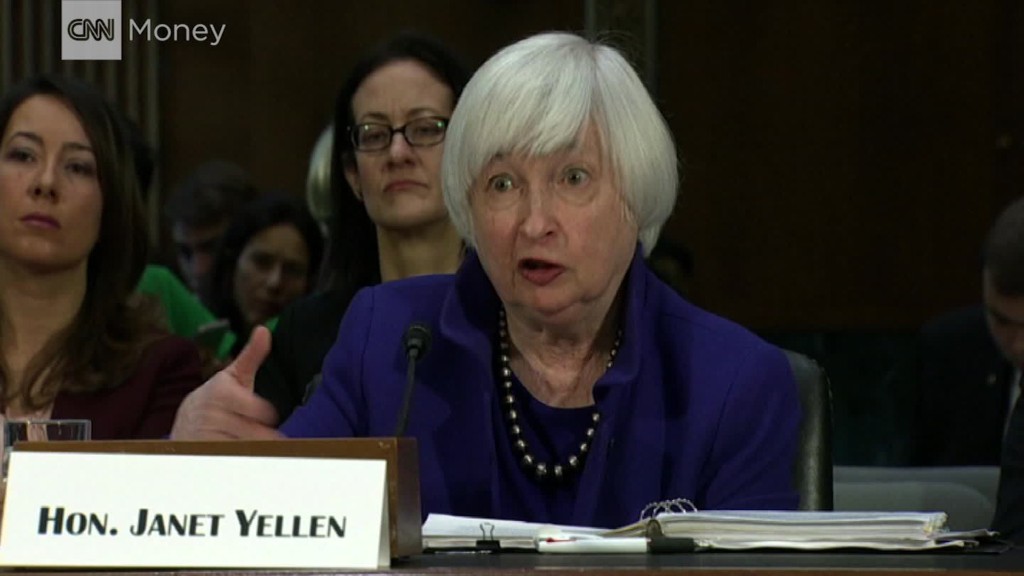
Wall Street banks have enough armor to shield Americans from another financial crisis.
The Federal Reserve on Thursday released initial results of its yearly stress tests to determine whether the nation's biggest banks are financially strong enough to weather a severe recession.
All 34 financial institutions, including Bank of America (BAC), JPMorgan Chase (JPM), and Citigroup (C), would be able to continue to lend to even under grim economic conditions -- a 10% unemployment rate, a sharp decline in housing prices and a severe recession in the eurozone.
"This year's results show that, even during a severe recession, our large banks would remain well capitalized," Federal Reserve Governor Jerome Powell said in a statement. "This would allow them to lend throughout the economic cycle, and support households and businesses when times are tough."
Next week, banks will learn whether the Fed is blocking or approving its plans to buy back stock or pay dividends to shareholders.
Related: Trump gives banks (a lot of) what they want
Regulators were looking for two key pieces of information. One, whether banks have enough capital to survive economic turmoil in the financial system. And two, whether firms were good at identifying and measuring risk when they craft their plans.
The Fed can reject a bank's capital plan for either reason.
This is the seventh year in a row the Fed has run stress tests, which were put in place after the financial crisis.
Since 2009, the nearly three dozen firms have added more than $750 billion in capital to their coffers. Thanks to their larger store of capital, banks are able to shoulder financial losses, like heightened stress in the corporate loan markets or commercial real estate.
Related: Mnuchin: Housing finance reform a 'priority' for Trump White House
Each year, regulators tweak the exam to keep banks on their toes. Regulators also want to test each bank's ability to guard against potential financial shocks.
Banks will get the chance to revise their capital plans before next week's results are released. But any bank that fails will have to draw up new plans and won't be allowed to pay dividends to shareholders until it has been approved by regulators.
For the third year in a row, all the banks maintained capital levels above the minimum the Fed requires.
Even after being pounded by a severe economic downturn, banks collectively had a 9.2% capital buffer, staying well above the Fed's minimum of 4.5%. That was better than last year's results.
Related: Trump signs orders that take aim at Dodd-Frank
President Trump has vowed to scrap many regulations on banks, particularly those that he says have suppressed lending. Trump has promised to undo various restrictions on financial firms that were put into place after the 2008 financial crisis, including the 2010 Dodd-Frank Act.
"I have so many people, friends of mine, that had nice businesses," Trump said in February. "They can't borrow money. They just can't get any money because the banks just won't let them borrow it because of the rules and regulations in Dodd-Frank."
The banking industry -- and the Trump administration -- are likely to claim the results give them more ammo to ease Obama-era financial rules.
"The strong capital levels also make it politically easier for Team Trump to push its deregulatory agenda," said Jaret Seiberg, an analyst at Cowen Washington Research Group, in a note to clients.
Revising the Fed's annual stress tests is one of more than 100 recommendations the Treasury Department has suggested to lessen the burden on banks, including limiting the number of financial firms that must face the exams.
Rich Foster, senior vice president and senior counsel for regulatory and legal affairs at the Financial Services Roundtable, seized on the latest bank scorecard by the Fed, saying: "Now is the time to move forward with Treasury's recent recommendations."
Even though some bankers say they would be lending more without the Dodd-Frank rules, lending has grown. Data suggests it has been a lack of demand, not supply, that is tamping down borrowing by U.S. companies.
"Lending has expanded overall by the banking system, and also to small businesses," Federal Reserve Chair Janet Yellen said in February. Compared with their global competitors, American banks are "generally considered quite strong. They've built up quite a bit of capital, partly as a result of our insistence that they do so," she added.
American banks raked in record profits last year, and they even have enough cash to reward shareholders with sizable dividends. Bank dividends hit $102.8 billion in 2016, according to the FDIC. That's just a tad shy of the record shelled out in 2007, the year before the financial meltdown.


